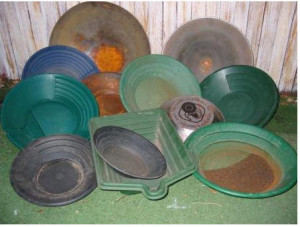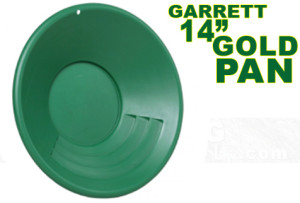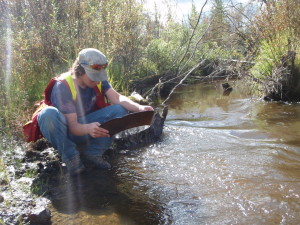There is a whole world of tools to assist in gold prospecting out there. Every day you hear of a new innovative product that will do all the work for you and leave you with clean gold while you sit in your lawn chair and drink beer. Some of these claims are true, most are partially true or only work under ideal conditions.
There are concentrator jigs, highbanker sluices, magnetic machines, trommels of all shapes and sizes, rockers, dredges, blue bowls, miller tables and anything else you can imagine.
The quintessential tool for any prospector is and always has been the gold pan. It is the go to tool in the prospector’s tool kit. The concept is quite simple, you shovel gold bearing gravel into the pan, agitate it and allow the more dense material to reach the bottom. You then remove the lighter material from the upper layer and re-agitate. After repeating the motion several times you are left with only the dense material including gold. Everyone has their own little tricks for panning, including myself, but it all boils down to the same thing.
Gold pans have not changed dramatically over time, historically they used a metal, shallow smooth pan. Much like the one in the photo below. That’s me in the photo, I was on an exploration trip in the Yukon and found that pan in an old cabin. It was old and rusty but still worked.
Today there are many styles of pans available with different kinds of riffles and shapes. There are square pans, pyramid pans (which I’ll cover in a future post), and round pans. Also they come in different sizes from 6″ to 30″. Essentially the larger the pan, the more material you can run.
Realistically a pan is not a production gold separator by today’s standards. You will really use a pan to test areas to see if and how much gold is present. So a gigantic one doesn’t make a lot of sense. I use 14″ pans in the field for testing, they allow a reasonable amount of material to get an idea of the potential grade. I also have some smaller pans around 8″ diameter. They are great for the concentrating process after you have collected your samples.

I prefer the green plastic pans made by Garrett. The plastic gets roughed up over time and works to keep gold in the pan. Also they have very effective riffles and a smooth side for finer panning. The green color shows the gold really well. Black works OK but in my opinion green is the best for spotting small gold.
I don’t like metal pans for a couple reasons, they are heavier which matters to me because I go to a lot of rugged areas that require hiking in. They have less aggressive riffles. Metal pans are also susceptible to rust and they require that the oils left over from manufacturing be burned off prior to use.
As a beginner or experienced gold panner I recommend plastic pans. Check out the links below to get some for yourself.
Garrett 14″ Gold Pan ($10.60)
 I have three of these pans and they work great. The big riffles make it easy to move lots of material. The gravity trap in the bottom holds fine gold very well. They are tough! I have fallen on them and dropped them down rock faces and they do not crack. Also the green color makes gold extra visible.
I have three of these pans and they work great. The big riffles make it easy to move lots of material. The gravity trap in the bottom holds fine gold very well. They are tough! I have fallen on them and dropped them down rock faces and they do not crack. Also the green color makes gold extra visible.
VAS 8″ Gold Pan ($5.79)
I have a couple of these smaller pans that I use for cleaning up samples and panning small amounts of material. This is a versatile pan, the large riffles work well when you have the pan full. I use the smaller riffles most of the time for fine panning. This pan also has a trap in the bottom like the Garrett and a similar green color.
have a couple of these smaller pans that I use for cleaning up samples and panning small amounts of material. This is a versatile pan, the large riffles work well when you have the pan full. I use the smaller riffles most of the time for fine panning. This pan also has a trap in the bottom like the Garrett and a similar green color.


Great Web Site
I like how you suggest using a pan with riffles and shapes when looking for gold. My dad likes to do outdoor activities and he also likes to look for precious metals. It would be nice to start a new hobby and purchase tools that can help us find gold.